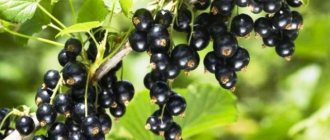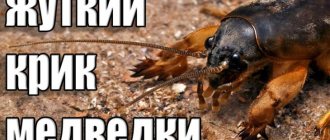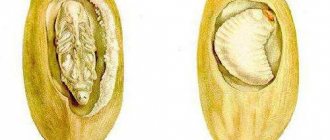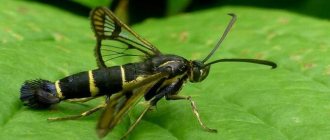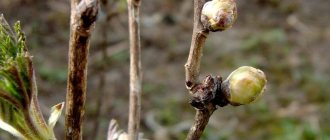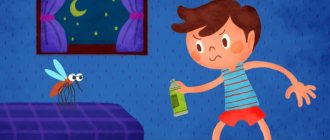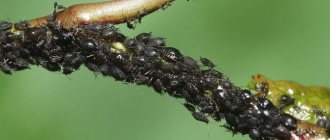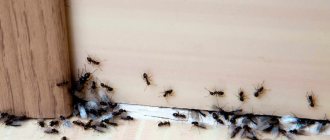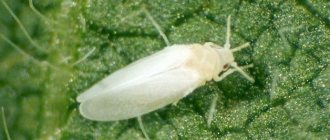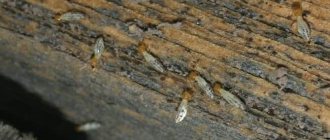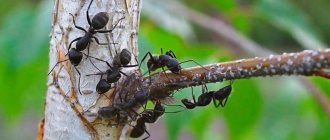Aphids are a real disaster for summer cottages. It causes enormous damage to plants, sucks out juices, and leaves wounds on the leaves through which viruses penetrate. In addition, aphids deform leaves, eat young shoots, and destroy flower ovaries, reducing the yield.
Ants that crawl along currant branches feed on aphids. In search of nectar, they climb into the inflorescences, preventing the berry from forming. They transmit fungi and viruses to the plant. Ants, building anthills under a currant bush, dig through underground passages and damage the roots of the plant. In addition to currants, aphids also attack other plants, infecting the entire garden.
Types of aphids that harm red currants
Red currants are attacked by two types of aphids: shoot and leaf (gall). In addition to the fact that it differs in appearance, the methods of dealing with it are also different.
Shoot aphid
This species is found on gooseberries and black currants, as well as apple trees, plums, and pears. The peak of its reproduction is May-June, when young succulent shoots appear on bushes and trees. Shoot aphids look like small bugs with an ovoid body of light green color.
During the season, 8-12 generations of shoot aphids are replaced. Damage to the plant is caused by larvae and females. They stick to young succulent shoots, take away all the juices, causing the leaves to curl. They form dense cocoons, inside which a colony of parasites settles. As the colony grows, it looks for new places for parasitism and attacks fresh shoots. If measures are not taken in time, the currants will dry out and die.
Shoot aphid
Work on eliminating shoot aphids should begin with the first thaw. Starting from mid-February, daytime temperatures become above zero. During this period, fertilized eggs laid at the base of the kidneys awaken. The larvae are distributed throughout the kidney, feeding on juices. It can be immediately noticed: it is larger than healthy kidneys, deformed and dry to the touch. On bare branches it is most convenient to carry out the first preventive measures to destroy shoot aphids.
Gall (leaf) aphid
Gall aphids differ in appearance from shoot aphids. Its bugs have not a smooth, but a terry surface. If zoomed in, it would be clear that their body is covered with hairs. It settles not on young shoots, but on the underside of the leaf. Her principle of sabotage is also somewhat different. If the shoot aphid feeds on plant juices, the gall aphid makes a puncture on the surface through which it feeds and leaves waste products. A growth called a gall forms on the leaf. If you turn it over, you can see a colony of gall aphids under the leaf. Other viruses and microorganisms enter the injection hole, causing the plant to die. The peak breeding season for gall aphids is June. At the end of July, when the foliage becomes coarser, the aphids lay eggs, which live not in the buds, but under the bark. They mature for 250 days, i.e. approximately 9 months. If the eggs are not destroyed in time, several hundred individuals will form in their place in May. Unlike shoot aphids, gall aphids migrate to other plants and trees at the end of July. This type of pest mainly attacks red currants because their foliage is more delicate compared to black currants.
Appearance of gall aphids
Gall formed on a currant leaf
The relationship between the type of drug and the treatment period
There are drugs of contact and systemic action. Contact ones only work when there is direct contact with a pest, egg laying or mycelium. Systemic ones act through plant sap, they are absorbed by the leaves and spread to all parts, including even the roots. Wherever there is a pest that decides to feast on the plant, it will die. From this we can conclude that systemic drugs need to be treated during the growing season, when there are leaves, at the earliest - along the green cone. And contact ones are more effective before the buds open, since only bare branches can be thoroughly treated. On currants with leaves that have already blossomed, the pests have woken up and spread throughout the entire bush; it is impossible to reach everyone with the solution.
Bud bursting is a borderline moment: before it, currants are treated with some drugs, after it - with others.
The packaging of the drug may not indicate whether it has a systemic or contact effect. Then read the instructions when it can be sprayed: on the leaves, before buds open, at a certain temperature, etc. Many are suitable for treatment in any season, only the concentration of the solution changes.
Natural remedies for treating currants against aphids
Treatment with insecticides is not always safe, especially if there are hives near the summer cottage. In addition, during late processing, the particles of the drug do not have time to wash off and remain on the berries. In this case, natural means of pest control are needed.
Laundry soap
An excellent remedy in the fight against shoot aphids. The principle of operation is simple: aphid bugs are covered with a waxy shell, and soap is an alkali that destroys it. In addition, the main active component of soap, caproic acid, is an antibiotic. The most effective is 72% soap, which is grated or cut into slices with a knife, pour 1 liter of water per 100 g of soap and infuse until completely dissolved. Before spraying, the workpiece is mixed with 9 liters of water, resulting in 10 liters of solution. To increase efficiency, add 100-200 g of vegetable oil, which is less easily washed off by rain. You need to process both the upper and lower parts of the leaves, as well as the inflorescences.
Other means
Liquid tar soap is also suitable, but in proportions of 125 ml per 10 liters of water. Cosmetic soap cannot be used. There is an option of spraying with a solution of tobacco dust and hot pepper. But there is a significant drawback - irritation of the human respiratory tract. And, unlike a soap solution, the effectiveness of tobacco-pepper spraying decreases after rain.
Another important condition: spraying with laundry soap is effective only in May, when aphids have not formed huge colonies. In June-July it is better to use special preparations.
Classification of drugs by purpose: fungicides, insecticides, acaricides
Systemic and contact preparations for processing currants are divided into three more groups:
- Fungicides are remedies for fungal diseases (Bordeaux mixture, HOM, Ridomil, Arcerid, Skor, etc.). Moreover, each drug in this group is universal, that is, you do not need to buy one for powdery mildew and another for anthracnose. Anyone can kill all the fungi existing on currants.
- Insecticides are pesticides used to control insects. Their brightest representative is Inta-Vir. But such products are not effective against ticks. There are exceptions - universal insecticides for all pests. One of them is Karbofos.
- Acaricides are substances that kill ticks. The most popular of them: Aktara and Aktelik. What’s interesting is that these products, like Karbofos, are universal; they kill not only ticks, but also insects.
There are many different drugs sold in stores, but they can all be grouped into three groups: against diseases, insects and ticks.
I really don’t understand why there is such confusion. Apparently, manufacturers want us to buy many different drugs: one for bud mites, the second for aphids and moths. Once I bought a fungicide with the inscription: against powdery mildew on roses. However, it coped well with spotting on strawberries. In order not to fall for “commercial baits”, not to buy a lot of unnecessary drugs and not torment myself and the currants with numerous sprays, I buy one fungicide and spray it literally all over my garden. I use universal pest control products. As a result, I do one spraying against all diseases on all crops, and the second against all pests. I found two effective fungicides for myself - HOM and Skor, and two pest control agents - Karbofos and Aktaru. I alternate them so that the parasites do not develop immunity.
Video: when and with what to spray currants
Plants susceptible to aphid damage
It should be noted that there is no particular difference between the methods of destroying shoot and gall aphids. It also does not matter what drug to treat this or that plant. The only difference is in the dosage, but instructions are usually included with the drug. It also happens that, no matter how you treat the bushes, aphids appear on it again soon. And all because there are plants that are especially attractive to the pest. These include:
- viburnum. This medicinal plant blooms quite early, attracting aphids awakened after winter with its young leaves. Therefore, before you start processing red currants, you need to process viburnum;
- Apple tree. This applies to young trees with tender, succulent shoots. Aphids especially harm petioles, which dry out and fall off. If you do not treat the tree, the colony of pests will spread throughout the garden;
- roses. Aphids love buds and shoot ends;
- peppers. Aphids cover green leaf blades and ovaries with a continuous carpet, which is why almost the entire harvest is lost;
- cabbage. Its succulent leaves are especially attractive to aphids. As a result, the cabbage turns yellow and a normal head of cabbage does not form;
- cucumbers Their fresh greens seem especially attractive to aphids. She also does not disdain young ovaries. Timely spraying will help save the crop;
- loves aphids and flowers, especially nasturtium. Sometimes it is recommended to plant it next to currants as a bait plant. It is much easier to destroy several colonies by tearing out a flower than to wage a painstaking fight on a large bush.
Vinegar
You can sprinkle currants with any known remedy that every housewife has in her kitchen. Vinegar against aphids helps save currants at any time during the growing season. Calmly use on a bush with berries.
Homemade recipes for aphids
Dilute 200 ml of table vinegar in 1 liter of cool water. Add 9 liters of liquid and 100 g of soap. The solution must be prepared immediately before use. Currant protection lasts 1-2 weeks. Depends on weather conditions. Vinegar drives away pests with its sour taste and pungent odor.
Important!
An effective vinegar-based aphid repellent requires precise dosage. An increased dose of acid leads to yellowing and death of leaves.
How to get rid of aphids on currants - useful video
This video describes an effective method of treating currants against aphids, which allows you to get rid of the pest before the end of the season. We advise all gardeners and gardeners to watch it!
I noticed that the treatment needs to be carried out comprehensively, i.e. simultaneously process currants, gooseberries, apple trees, pears, plums, viburnum and other trees and shrubs. The main thing is to do everything on time. It is imperative to pluck off damaged leaves and shoots if it is not possible to spray the bushes with a stream of water a few days after treatment. Currants are responsive to care, and, having received protection and care, will delight you with a good harvest in any weather conditions.
Prevention
Preventing the appearance of aphids on currants is much easier than fighting numerous colonies of the pest. Do not neglect simple but effective prevention methods:
- Annual rejuvenating and formative pruning of currants . Remove diseased and old branches and shoots growing inside the bush. The absence of thickening and uniform ventilation of the shoots reduces the likelihood of aphids and facilitates early detection of the pest.
- Whitewashing with slaked lime . Spring treatment of the lower parts of the branches of the bush serves as protection against harmful insects.
- Timely weeding . Currant bushes overgrown with weeds become a target for aphids, which easily move to the branches of the crop from wild vegetation.
- Regular inspection of bushes . Allows you to identify the pest at an early stage of infection and begin control measures in time.
- Planting repellent plants in the tree trunk circle . Phytoncides and pungent odors reduce the risk of aphid invasion of currants.
- Fighting ants . Detection and destruction of anthills in the garden reduces the spread of aphids on berry bushes.
To effectively combat aphids, it is important to promptly identify the pest colony and take emergency measures to destroy it. The gardener has a large number of preparations and means in his arsenal that allow him to get rid of harmful insects in a short time. Preventive measures against aphids reduce the risk of a massive pest invasion.
Celandine
For small garden pests, herbs are used - tansy, wormwood, thyme. Celandine against aphids shows high efficiency.
It is necessary to pick several plants entirely. You should work with gloves. Grind, throw in a bucket, pour 10 liters of water, let it brew for a day. Strain the tincture, add 100 g of laundry soap. Currants are sprayed with the solution, deformed shoots and twigs are soaked. Green aphids are especially afraid of such procedures.
Folk remedies allow you to get rid of aphids without chemicals. May be used at any time during the growing season.
Mustard
Folk methods of struggle cannot do without spices, spices with a pungent, persistent odor.
- Mustard against aphids is used in the form of a solution. For 10 liters of water, 10 liters of dry powder are required; soap is added at the end of preparation.
- If aphids attack, you can use red pepper. For 10 liters of liquid 200 g of spices. They insist for a day. Boil for 3 hours, add soap.
- Cinnamon will help remove aphids. You can throw it into the bucket in unlimited quantities.
Folk methods of fighting using spices allow their combination. If you pour a solution containing red, black pepper, cinnamon, and mustard over the currants, you can forget about the presence of aphids for the next month.
